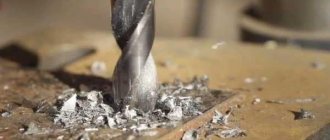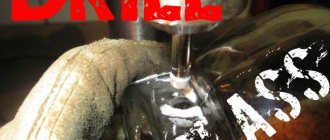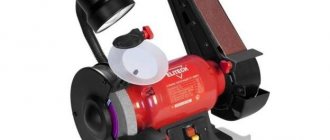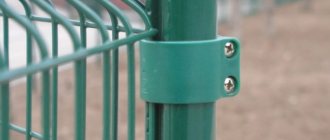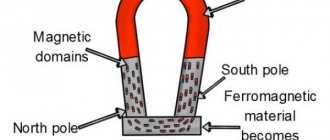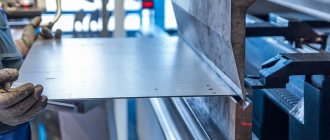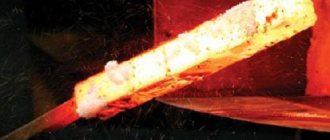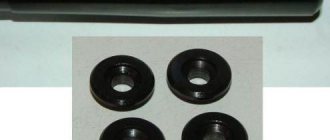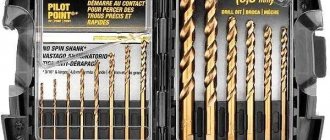It is better to drill steel before the heating process, since this will not cause any difficulties. If you come across a hardened workpiece (of great thickness), release it, drill holes with a standard drill and re-harden if the situation requires it. However, this option is not always possible. There are often situations when you need to make a hole in a steel workpiece, but it is already heavily hardened. In production and by folk craftsmen, many options and technologies for drilling hardened steel have been created. You need to proceed from the situation, the materials that are at hand. An obligatory factor is the goals for which this work is required.
At home
Sometimes, to get a hole, it is enough to make a slot with a grinder. Pass a screw through it, then secure the workpiece. To make the hole smaller, it needs to be made from 2 sides. In this case, the disk of the smallest diameter is used. A practically erased disk would be better.
Before work, the steel must be examined for hardness. Based on this, choose a method. If the workpiece bends well, a drill with pobedit tips will do, i.e. on concrete. A prerequisite is that it must be spicy. You can sharpen it with a diamond wheel. Otherwise, the use of special tools is required.
During work, the workpiece is pressed tightly with a drill, and high speeds are set. The drilling site is pre-lubricated. It would be better to initially use a drill of a smaller diameter, and then replace it with a larger one. This reduces the resistance area and increases efficiency.
If a special drill made of carbon steel is used, you need to work taking into account the following subtleties:
- Do not press the drill too hard against the workpiece;
- Do not turn on high speeds.
The following method will take from 2 hours. First, the metal is etched with sulfuric or nitric acid. A side is made from paraffin, and acid is placed there. The diameter of the “eye” turns out to be slightly wider than the side itself, so when making it, this nuance is taken into account. To speed up the process, the workpiece is heated to 50 degrees.
The hole is also made with a conventional welding machine. The place itself is burned or “released”, and then simply drilled. Melted edges must be sanded.
Nuances when drilling
The technology in question has a fairly large number of features that need to be taken into account. Drilling of hardened metal is carried out taking into account the following points:
- Before carrying out work, pay attention to the hardness of the surface. This parameter is used to select the most suitable drill. Hardness can be determined using a variety of technologies.
- During drilling, a large amount of heat is generated. This is why rapid wear of the cutting edge occurs. In this regard, in many cases, cooling liquid is supplied to the cutting zone.
- When cutting difficult-to-cut material, it is necessary to sharpen the cutting edge from time to time. For this, a conventional sharpening machine or a special tool is used. Only diamond-coated wheels are suitable as an abrasive.
Steel Drilling Tool
There are a variety of methods for cutting hardened steel. Some of them significantly simplify the processing. Only by taking into account all the nuances can the quality of the resulting hole be improved.
In production
To drill thicker hardened workpieces, special machines are used. In them, the drill is mounted in a special drill chuck, which is secured with a conical tail in the tailstock quill. Drilling work is carried out thanks to the linear feed of the drill and the quill feed wheel. At the same time, both the workpiece and the drill rotate. The maximum usable drill diameter is 1.5 centimeters. Large drills are secured with a tail with adapter sleeves. They come in standard sizes. They are called Morse cones.
Drills are:
- Spiral with cylindrical and conical shanks. They can drill not only hardened steel, but also cast iron, as well as other “strong” materials;
- With inserts made of carbide materials. Also suitable for thick, hardened steel;
- Deep drill bits. They are used in cases where a hole is made with a depth of 5 times the diameter of the drill.
Before work, the surface of the workpiece is processed. A recess is also made with a centering drill. Otherwise, the drill begins to “walk” in front of the steel sheet, and the hole moves away from the central axis of rotation.
The depth of the hole is controlled by notches with markings on the quill. If there is a dial on it, then the drilling depth will be accurate to 0.01 millimeters. Drilling must be done in several stages. Having made a hole 2 mm deep, the drill is removed from the steel and chips are removed (from the hole and drill outlet channels). After which the process continues. If you do not follow this technology, the drill may jam and break. Don't forget to use lubricant.
Before you start drilling, you must remember that the diameter of the hole is larger than the diameter of the drill. This value is called breakdown. For a drill with a diameter of 1 centimeter, the breakdown will be 0.15 millimeters. Splitting occurs due to insufficient precision during drill sharpening.
To obtain a high-quality hole, the first step is to use a drill whose size is 70% of the diameter of the required hole. At the second stage, it is changed and the required size is used. More precise processing is obtained using countersinking and reaming.
Drill selection
Twist drills, which are represented by a vertical rod with two grooves, have become quite widespread. Due to the specific arrangement of the grooves, a cutting edge is formed. Among the features of the choice, we note the following points:
- The pobedite drill bit has become quite widespread. It can be used to work with various hardened alloys. However, a surface with too high hardness cannot be processed with such a tool.
- The choice is also made based on diameter. It is worth considering that it is quite difficult to obtain a large diameter hole. The larger diameter version is much more expensive due to the use of a large amount of material in its manufacture.
- Attention is also paid to the sharpening angle, the purpose of the product and the type of material used in manufacturing. For example, cobalt versions are characterized by higher resistance to high temperatures.
- It is recommended to pay attention to products exclusively from well-known manufacturers. This is due to the fact that Chinese versions are manufactured using low-quality materials. However, such an offer is much cheaper and can be used for short-term or one-time work.
- When choosing a drill, you can be guided by the markings. It can be used to determine which materials were used in production. The diameter of the hole that can be obtained when using the tool is also indicated.
Drill for hardened steel
In a specialized store you can find almost everything you need to carry out the work. However, the fairly high cost of the product and some other factors determine that some decide to make a drill themselves from scrap materials. Similar work can be done if you have the required tools.
Size control
After obtaining the holes, size control is carried out. A caliper is used for measurements. If the hole made has ledges, or the length of the measuring jaws of the caliper is not enough to measure the size of the hole, gauges (measuring plugs) are used. These are two measuring cylinders. One of them is equal to the diameter of the hole, the second is 0.3 mm larger. During measurement, a cylinder “to size” is immersed in the “eye”, but the second one should not enter there. In case of piece production, such calibers can be made yourself. In production, instruments with high measurement accuracy are used.
Application of lubricants
- The drilling area on hardened metal is marked with a core. Apply a small amount of lubricant to this point. If it is liquid, then squeeze out a drop of oil so that it does not spread.
- The cutting area of the tool is dipped into the lubricant and placed at the previously marked point.
- When drilling hardened metal, monitor the amount of lubricant and add it as it is used up.
- Monitor the heating status of the instrument, preventing it from overheating. Intensive smoke emission from burning lubricant indicates the need to stop work and cool the equipment and metal.
How to drill with a drill?
Drilling metal with a drill requires following some recommendations:
- To make a hole you will need an electric drill, a core punch, a hammer, machine oil and safety glasses.
- Initially make markings.
- Wear safety glasses.
- When the pressure on the drill is low, you need to select the low speed position and start working.
- Don’t forget to water the area being treated with coolant.
If you follow the technology and use high-quality tools, you can make holes of different diameters and depths. To drill straight holes or accurately select the depth, you can use a device called a “depth stop.” It is attached to an electric drill and adjusted to the desired depth.
Drilling metal with a drill
Tool selection
In factories and enterprises where the processing of cast iron workpieces is carried out on a wide stream, drilling machines are equipped with an emulsion supply to the point of contact of the drill. This technological move allows you to avoid phase transformations in the treated area. A special requirement for drilling machines is the increased requirement for the ability to control and smoothly change the speed of rotation of the cutting tool and the feed into the workpiece. Specially developed substances are often used as emulsions. These are mainly sulfonated and chlorinated oils. For gray cast iron, kerosene can be used. If there is no need to speed up the process, gray cast iron can be drilled without the use of a cooling lubricant.
At home, a drill with adjustable speed and quite powerful is used for drilling if it is necessary to drill a hole of significant diameter. If possible, be sure to use a device that locks the drill in relation to the workpiece. This will extend the life of the cutting tool. The main reason for its failure is misalignment, deviation from the vertical drilling axis.
Drilling rolled steel
Drilling holes in metal is one of the types of mechanical processing to produce through and blind holes of the required diameter. The essence of the process is to secure the workpiece, marking and processing with manual or automated tools.
Drilling equipment
The type of equipment is chosen depending on the tasks assigned. Drilling machines can be radial drilling, vertical drilling, coordinate drilling. With their help they perform:
- through and blind holes with cylindrical walls;
- multifaceted, oval and other holes;
- internal thread;
- finishing;
- drilling an existing hole.
Use of lubricants
When drilling through hardened steel, serious friction occurs. That is why it is recommended to purchase and use various lubricants. Among the features of this processing method, we note the following points:
- First, the drilling area is processed. A small amount of lubricant is applied to the surface where the hole will be located.
- Oil is added to the cutting edge. To process hardened steel, a small amount of the substance is required, but it must be added from time to time, since it scatters when the tool rotates.
- During work, it is recommended to take breaks to cool the cutting surface and the surface being processed.
Lubricating steel with special oil
Special oil not only simplifies drilling, but also increases the service life of the tool used.
This is because oil can reduce the temperature of the cutting edge.
Devices to facilitate the process
Cutting fluid is used in many types of metal cutting. Most often it is used for deep drilling to reduce friction forces and stabilize the temperature of the working tool. A high-quality liquid does not cause surface corrosion, is safe for humans, does not have an unpleasant odor and removes heat well.
The following is used as a lubricant for drilling metal at home:
- Technical Vaseline – for soft materials.
- Soap solution - for aluminum.
- Turpentine with alcohol - for silumin.
- A mixture of oils - for tool and alloy steels.
Some craftsmen prefer to use a universal composition, which includes laundry soap (200 g) and motor oil (20 g). The components are mixed and boiled until a homogeneous emulsion is obtained.
The use of industrially produced cutting fluids makes it possible to increase the speed of drilling various types of metal. For example, when processing stainless steel, productivity increases by 30%. For cast iron this parameter increases to 40%.

